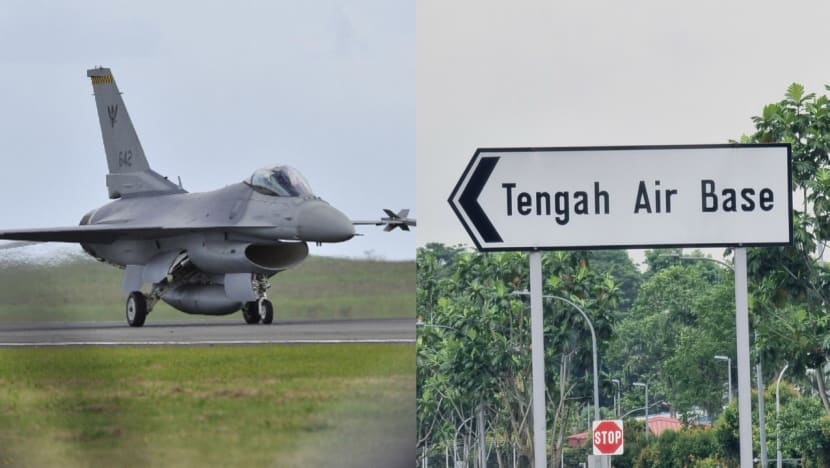Degraded components led to malfunction that caused F-16 crash: MINDEF
Two out of four pitch rate gyroscopes in the aircraft had degraded due to wear and tear and failed during take-off.

A Republic of Singapore Air Force (RSAF) F-16 fighter and a sign pointing towards Tengah Air Base. A RSAF F-16 jet crashed at Tengah Air Base shortly after taking off on May 8, 2024. (File photos: AFP/Paul Crock, CNA/Raydza Rahman)

This audio is generated by an AI tool.
SINGAPORE: Degraded components known as pitch rate gyroscopes led to a malfunction that resulted in the crash of an F-16 jet on May 8, the Ministry of Defence (MINDEF) said on Wednesday (Jun 19) after investigations concluded.
Pitch rate gyroscopes are sensors that a flight control computer uses to control an aircraft and all F-16 fighter jets are fitted with four such gyroscopes.
The pilot was unable to control the plane at take-off because its pitch rate gyroscopes gave erroneous inputs to the flight control computer, MINDEF said on May 18.
The pilot responded "in accordance with emergency procedures" and ejected within Tengah Air Base before being evacuated to hospital.
Training for Singapore's F-16 fleet was temporarily suspended in the wake of the crash but resumed after the cause of the crash was identified.

WHAT HAPPENED
MINDEF said in its update on Wednesday that two out of four pitch rate gyroscopes in the aircraft gave "erroneous but similar inputs" to the digital flight control computer.
It was found that the two gyroscopes had degraded due to wear and tear and failed during take-off.
Former Republic of Singapore Air Force (RSAF) pilot Ong Swee Chuan previously told CNA that at any one time, three out of four of them are used and the average of two is taken to provide data to the flight control computer,
With two gyroscopes registering erroneous inputs that were similar, the flight control logic "accepted" them as "correct" while rejecting the inputs from each of the remaining functioning gyroscopes as "incorrect", said MINDEF.
"This caused the digital flight control computer to manoeuvre the aircraft in response to the erroneous pitch rate feedback signal from the two degraded gyroscopes, making the F-16 uncontrollable by the pilot," it added.
NO FAULT DETECTED BEFORE TAKE-OFF
The investigation, which was led by the RSAF and supported by Lockheed Martin and the Transport Safety Investigation Bureau, also concluded that the F-16 aircraft was maintained according to established protocols.
The RSAF had adhered to required maintenance inspections, said MINDEF, noting that F-16's gyroscopes are the same as those used by other F-16 operators around the world.
"Lockheed Martin does not stipulate any preventive maintenance for these gyroscopes," it added. "The gyroscopes are to be replaced when a fault is detected."

MINDEF added that the F-16's pre-flight built-in test "did not detect any fault" with the aircraft's gyroscopes before take-off.
"It is assessed that the two pitch rate gyroscopes had degraded due to wear and tear and failed during take-off," said MINDEF.
It added that the RSAF has put in place an additional preventive maintenance procedure for the gyroscopes to reduce the chance of a reoccurrence.
RSAF engineers will periodically remove the F-16 gyroscope assemblies and test them using specialised equipment to increase the likelihood for engineers to detect early signs of degradation, said the Defence Ministry
This will allow them to "pre-emptively replace the gyroscopes, before the gyroscopes reach the stage of accelerated degradation leading to failure".
This measure is over and above the prescribed aircraft manufacturer's maintenance procedures, noted MINDEF.
It also said that each RSAF F-16 aircraft's flight control gyroscopes had been checked and cleared before it resumed F-16 flights on May 21.
"According to Lockheed Martin, this is a rare occurrence and the first such failure reported to it since the F-16s first flew in 1974," said MINDEF.
With approximately 3,100 F-16s operating in 25 countries and over 19 million flight hours, MINDEF added it remains "confident in the operational capability and reliability of the F-16 to defend Singapore's skies".












